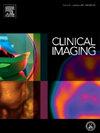Outcomes following pre-operative MRI-guided bracketing in breast cancer patients
IF 1.5
4区 医学
Q3 RADIOLOGY, NUCLEAR MEDICINE & MEDICAL IMAGING
引用次数: 0
Abstract
Introduction
This study aimed to evaluate the surgical outcomes of patients undergoing magnetic resonance imaging-guided bracketing (MRI-B) prior to breast-conserving therapy (BCT).
Materials and methods
This retrospective study included consecutive patients treated with BCT at our institution for invasive or in situ breast cancer between January 2016 and December 2022 and requiring MRI-B before surgery. Bracketing was performed by either inserting MRI-compatible wires or deploying clips under MRI guidance, with subsequent localization using mammography. Clinical, radiological, and pathological data were collected and correlated with positive surgical margins and imaging overestimation.
Results
Among the 57 patients included, 10 (18 %) had positive surgical margins. Younger age (Mean: 56 vs 49 years) and the presence of ductal carcinoma in-situ (DCIS) or infiltrative lobular carcinoma (ILC) component (100 % vs 82 %) were most strongly associated with positive margins, although statistical significance was not reached (P = 0.11 and P = 0.149, respectively).
MRI overestimated disease extent in 13 of 49 eligible patients (27 %). Overestimation was most strongly linked to isolated infiltrating ductal carcinoma (IDC; 38 % vs. 3 %, P = 0.008) and bracketed enhancing foci (54 % vs. 22 %, P = 0.084).
During long-term follow-up, 2 patients (4 %) had local recurrence, and 3 patients (5 %) experienced distant recurrence.
Conclusions
MRI-B before BCT is associated with a clinically manageable rate of positive margins and local recurrence. However, optimizing patient selection is essential to minimize unnecessary bracketing and improve surgical outcomes.
乳腺癌患者术前mri引导下支架术的疗效
本研究旨在评估在保乳治疗(BCT)前接受磁共振成像引导下支架手术(MRI-B)的患者的手术效果。材料和方法本回顾性研究纳入了2016年1月至2022年12月期间在我院连续接受BCT治疗的浸润性或原位乳腺癌患者,术前需行MRI-B检查。通过插入与MRI兼容的导线或在MRI引导下部署夹子来进行支架置入,随后使用乳房x线摄影进行定位。我们收集了临床、放射学和病理数据,并将其与手术切缘阳性和影像学高估相关联。结果本组57例患者中,10例(18%)手术切缘阳性。较年轻的年龄(平均56岁vs 49岁)和导管原位癌(DCIS)或浸润性小叶癌(ILC)成分(100% vs 82%)的存在与阳性边缘最密切相关,尽管没有达到统计学意义(P = 0.11和P = 0.149分别)。49例符合条件的患者中有13例(27%)MRI高估了疾病程度。高估与孤立性浸润性导管癌(IDC;38% vs. 3%, P = 0.008)和括号增强焦(54% vs. 22%, P = 0.084)。长期随访中,局部复发2例(4%),远处复发3例(5%)。结论BCT前的smri - b与临床可控制的阳性边缘率和局部复发率有关。然而,优化患者选择是必要的,以尽量减少不必要的支架和改善手术结果。
本文章由计算机程序翻译,如有差异,请以英文原文为准。
求助全文
约1分钟内获得全文
求助全文
来源期刊

Clinical Imaging
医学-核医学
CiteScore
4.60
自引率
0.00%
发文量
265
审稿时长
35 days
期刊介绍:
The mission of Clinical Imaging is to publish, in a timely manner, the very best radiology research from the United States and around the world with special attention to the impact of medical imaging on patient care. The journal''s publications cover all imaging modalities, radiology issues related to patients, policy and practice improvements, and clinically-oriented imaging physics and informatics. The journal is a valuable resource for practicing radiologists, radiologists-in-training and other clinicians with an interest in imaging. Papers are carefully peer-reviewed and selected by our experienced subject editors who are leading experts spanning the range of imaging sub-specialties, which include:
-Body Imaging-
Breast Imaging-
Cardiothoracic Imaging-
Imaging Physics and Informatics-
Molecular Imaging and Nuclear Medicine-
Musculoskeletal and Emergency Imaging-
Neuroradiology-
Practice, Policy & Education-
Pediatric Imaging-
Vascular and Interventional Radiology
 求助内容:
求助内容: 应助结果提醒方式:
应助结果提醒方式:


